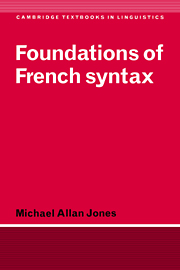6 - Pronouns
Published online by Cambridge University Press: 14 January 2010
Summary
Overview
In this chapter we will look at pronouns which, informally speaking, act as substitutes for NPs and other phrases in cases where a full description or use of a proper noun would be unnecessary or inappropriate. Other types of pronoun which have more specialised functions will be discussed in other chapters: negative pronouns in chapter 7, interrogative and relative pronouns in chapter 10.
A dominant theme of this chapter is that the Clitic-placement process outlined in 1.5.1 serves not only to account for constructions in which pronouns are attached to the verb but also to explain the conditions in which disjunctive pronouns (i.e. pronouns which are not attached to the verb) can be used.
In 6.2 and 6.3, this hypothesis is investigated in relation to structural conditions on the Clitic-placement rule, while 6.4 focuses on the semantic properties of different types of pronouns. In 6.5 and 6.6, we study in greater detail the properties of the so-called lsquo;adverbial’ clitics y and en, looking at questions such as the difference between y and Dative clitics as substitutes for expressions introduced by ä, the choice between en and possessive determiners as substitutes for phrases introduced by de within NPs and the various uses of en to replace indefinite NPs.
In 6.7, the structural relations between pronouns and their antecedents are studied, and the ways in which these relations determine the form of pronouns (e.g. reflexive vs non-reflexive forms), focusing particularly on differences between French and English.
- Type
- Chapter
- Information
- Foundations of French Syntax , pp. 245 - 309Publisher: Cambridge University PressPrint publication year: 1996

